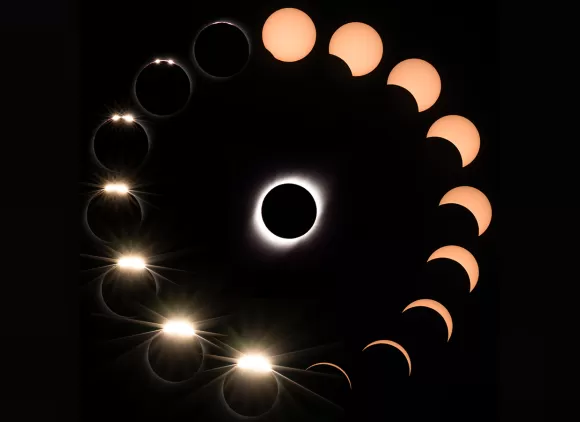Not in the path of the eclipse? Join scientists from the U.S. National Science Foundation and the NSF National Solar Observatory live on YouTube on April 8, 2024, at 1:55 p.m. EDT to learn about the solar eclipse and the science of the sun.
The livestream is a free resource that educators can use in their classrooms to share the excitement of science.
 On this page
On this page
Where and when can I view the solar eclipse?
On Monday, April 8, the path of the total solar eclipse will stretch in a line from Texas to Maine. A partial eclipse will be visible in all 48 contiguous U.S. states.
The map and table below detail the totality time and duration for a selection of U.S. cities.
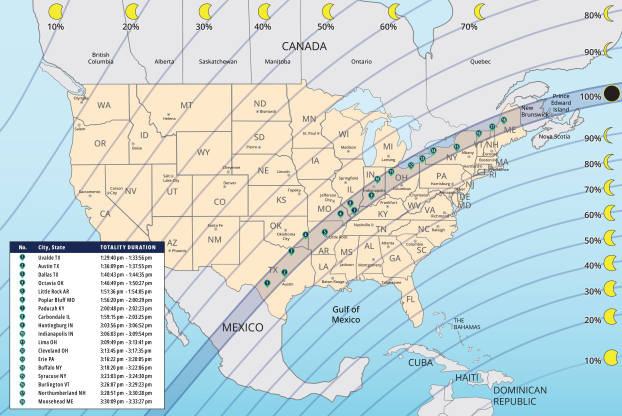
| No. on map | City, State | Totality duration (local time) |
|---|---|---|
| 1 | Uvalde, TX | 1:29–1:33 p.m. |
| 2 | Austin, TX | 1:36–1:37 p.m. |
| 3 | Dallas, TX | 1:40–1:44 p.m. |
| 4 | Octavia, OK | 1:46–1:50 p.m. |
| 5 | Little Rock, AR | 1:51–1:54 p.m. |
| 6 | Poplar Bluff, MO | 1:56–2:00 p.m. |
| 7 | Paducah, KY | 2:00–2:02 p.m. |
| 8 | Carbondale, IL | 1:59–2:03 p.m. |
| 9 | Huntingburg, IN | 3:03–3:06 p.m. |
| 10 | Indianapolis, IN | 3:06–3:09 p.m. |
| 11 | Lima, OH | 3:09–3:13 p.m. |
| 12 | Cleveland, OH | 3:13–3:17 p.m. |
| 13 | Erie, PA | 3:16–3:20 p.m. |
| 14 | Buffalo, NY | 3:18–3:22 p.m. |
| 15 | Syracuse, NY | 3:23–3:24 p.m. |
| 16 | Burlington, VT | 3:26–3:29 p.m. |
| 17 | Northumberland, NH | 3:28–3:30 p.m. |
| 18 | Moosehead, ME | 3:30–3:33 p.m. |
2024 total eclipse fact sheet
Learn about safety tips and where and when to view the total solar eclipse on April 8, 2024.
Join an NSF event
NSF is hosting a day of free, fun and educational eclipse events.
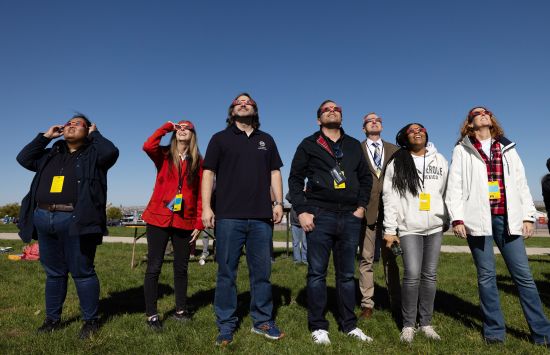
Solar Eclipse Festival on the National Mall
April 8, 2024, 12–4 p.m. EDT
In person, Free
National Mall, Washington, D.C.
NSF, in collaboration with the Smithsonian, NASA, NOAA, and the National Radio Astronomy Observatory presents an outdoor festival with activities for all ages.
Hosted by the National Air and Space Museum, the event will run from 12 to 4 pm along the National Mall between 4th and 12th Streets. Browse the many activity stations to view the sun in a variety of safe telescopes and explore the different educational activities.
The eclipse will be visible in the Washington, D.C. area between 2:04 p.m. and 4:32 p.m. Maximum eclipse will be at 3:20 p.m., with the sun 89% covered by the moon.
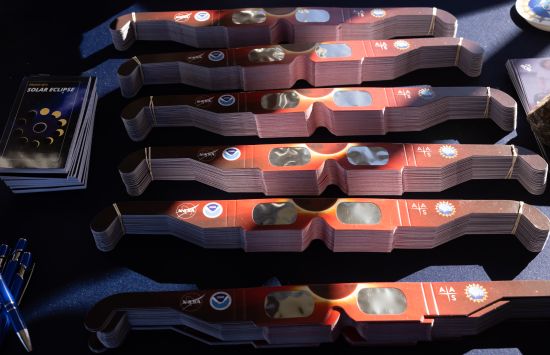
Sun, Moon and You: Dallas Cotton Bowl Solar Eclipse
April 8, 2024, 9:30 a.m. – 3:30 p.m. CDT
In person, Free (but must register for a ticket)
Fair Park Cotton Bowl Stadium, Dallas, Texas
On April 8th, join NSF, NOAA and NASA for the Sun, Moon, and You Solar Eclipse Viewing Event at the Fair Park Cotton Bowl in downtown Dallas, with special guest speakers, Neil deGrasse Tyson and “Ready, Jet, Go!” from PBS.
NSF, NOAA and NASA experts will talk about the science of the eclipse, space weather and why scientists study the sun. Multiple STEM organizations will be onsite throughout the stadium's concourse, providing activities and handouts. Telescopes will be available for viewing the eclipse and food for purchase.
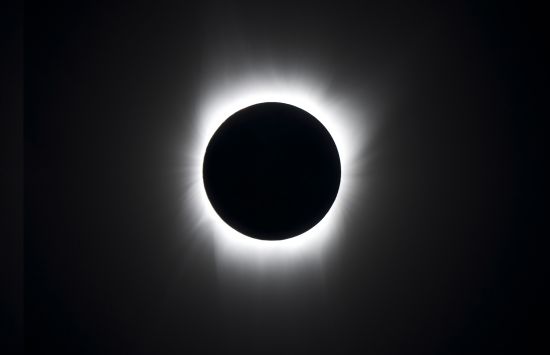
Don't just watch the eclipse — explore it. On April 8, NSF and the NSF National Solar Observatory are hosting an educational livestream all about the science of the sun.
The livestream is a free resource that educators can use in their classrooms to share the excitement of science. You'll hear from scientists about the unique experiments happening during the eclipse.
As we count down to the moment of totality, you'll learn about:
- The different layers of the sun, from the core to the corona.
- The NSF Daniel K. Inouye telescope, the world's largest, most advanced solar telescope.
- How massive solar eruptions generate space weather.
It all happens on YouTube on April 8 starting at:
- 10:55 a.m. PDT.
- 11:55 a.m. MDT.
- 12:55 p.m. CDT.
- 1:55 p.m. EDT.
How to safely view the solar eclipse

Looking directly at the sun without eye protection can cause serious eye damage or blindness, even when an eclipse is occurring.
The only safe time to view an eclipse without eye protection is during a total eclipse, when the moon completely blocks out the sun. Otherwise, you can safely view an eclipse by using:
- Special solar eclipse glasses that comply with the ISO 12312-2 international standard.
- A special-purpose solar filter that complies with ISO 12312-2.
- A pinhole projection.
- Regular sunglasses, no matter how dark, are not safe for viewing the sun.
- Always inspect your solar glasses or filter before use. Discard if scratched, punctured, torn or otherwise damaged. Read and follow any instructions printed on or packaged with your eye protection.
- Before looking at the eclipse, cover your eyes with eclipse glasses or a solar viewer. After glancing at the sun, turn away and remove your eye protection — do not remove it while looking at the sun.
- Viewing any part of the sun through a camera lens, binoculars or a telescope without a special-purpose solar filter secured over the front of the optics will instantly cause severe eye injury.
- Do not look at the sun through an unfiltered camera, telescope, binoculars, or any other optical device while using your eclipse glasses or handheld solar viewer in front of your eyes — the concentrated solar rays could damage the filter and cause serious injury.
- Always supervise children using solar filters or eclipse glasses. For more information on eclipse and eye safety, visit eclipse.aas.org/safety.
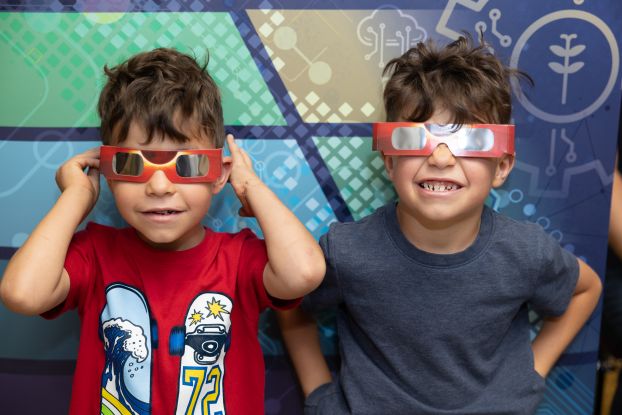
Credit: Charlotte Geary/U.S. National Science Foundation
Learn more about the solar eclipse

Discovery Files: Eclipses and Solar Observation
Carrie Black, a program director in NSF's Division of Astronomical Sciences who oversees operations of the National Solar Observatory, talks about eclipses, the sun and how scientists use tools such as the Daniel K. Inouye Solar Telescope to observe them.
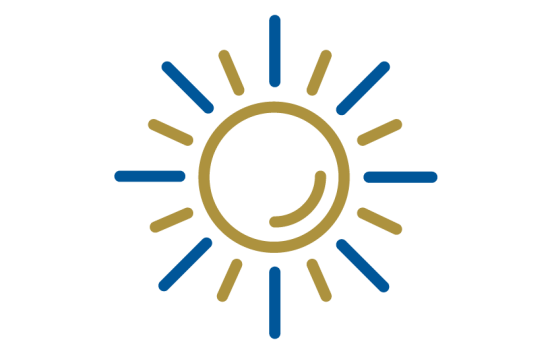
Citizen Continental-America Telescope Eclipse (CATE)
In collaboration with about 40 teams of citizen scientists, scientists from Southwest Research Institute will make observations of the sun’s corona during the 2024 total solar eclipse as it crosses the United States from Texas to Maine.
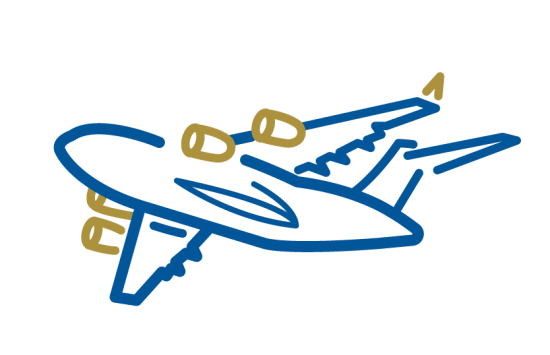
Airborne Coronal Emission Surveyor (ACES)
ACES is a new instrument that will be used to explore the infrared emissions of the sun’s corona. It will fly on the NSF/NCAR Gulfstream V aircraft along the eclipse's path of totality.



